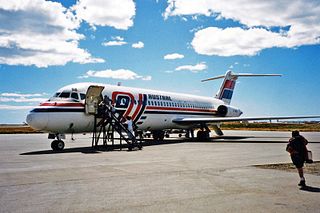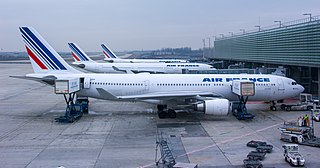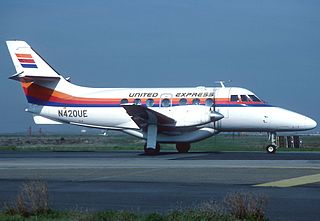
A pitottube, also known as pitot probe, is a flow measurement device used to measure fluid flow velocity. The pitot tube was invented by the French engineer Henri Pitot in the early 18th century and was modified to its modern form in the mid-19th century by French scientist Henry Darcy. It is widely used to determine the airspeed of an aircraft, water speed of a boat, and to measure liquid, air and gas flow velocities in certain industrial applications.

Air Florida Flight 90 was a scheduled U.S. domestic passenger flight operated by Air Florida from Washington National Airport to Fort Lauderdale–Hollywood International Airport with an intermediate stopover at Tampa International Airport. On January 13, 1982, the Boeing 737-222 registered as N62AF crashed into the 14th Street Bridge over the Potomac River.

Aviation safety is the study and practice of managing risks in aviation. This includes preventing aviation accidents and incidents through research, educating air travel personnel, passengers and the general public, as well as the design of aircraft and aviation infrastructure. The aviation industry is subject to significant regulation and oversight.

Northwest Airlines Flight 255, a McDonnell Douglas MD-82, crashed shortly after takeoff from Detroit Metropolitan Airport on August 16, 1987, at about 8:46 p.m. EDT, resulting in the deaths of all six crew members and 148 of its 149 passengers, along with two people on the ground. The sole survivor was a 4-year-old girl who sustained serious injuries. It was the second-deadliest aviation accident at the time in the United States. It is also the deadliest aviation accident to have a sole survivor.

Pan Am Flight 759 was a regularly scheduled domestic passenger flight from Miami to San Diego, with en route stops in New Orleans and Las Vegas. On July 9, 1982, the Boeing 727 flying this route crashed in the New Orleans suburb of Kenner after being forced down by a microburst shortly after takeoff. All 145 on board and 8 people on the ground were killed. The crash had the highest number of aviation fatalities in 1982.

USAir Flight 405 was a regularly scheduled domestic passenger flight between LaGuardia Airport in Queens, New York City, New York, and Cleveland, Ohio. On March 22, 1992, a USAir Fokker F28, registration N485US, flying the route, crashed in poor weather in a partially inverted position in Flushing Bay, shortly after liftoff from LaGuardia. The undercarriage lifted off from the runway, but the airplane failed to gain lift, flying only several meters above the ground. The aircraft then veered off the runway and hit several obstructions before coming to rest in Flushing Bay, just beyond the end of the runway. Of the 51 people on board, 27 were killed, including the captain and a member of the cabin crew.

A pitot-static system is a system of pressure-sensitive instruments that is most often used in aviation to determine an aircraft's airspeed, Mach number, altitude, and altitude trend. A pitot-static system generally consists of a pitot tube, a static port, and the pitot-static instruments. Other instruments that might be connected are air data computers, flight data recorders, altitude encoders, cabin pressurization controllers, and various airspeed switches. Errors in pitot-static system readings can be extremely dangerous as the information obtained from the pitot static system, such as altitude, is potentially safety-critical. Several commercial airline disasters have been traced to a failure of the pitot-static system.

Birgenair Flight 301 was a flight chartered by Turkish-managed Birgenair partner Alas Nacionales from Puerto Plata in the Dominican Republic to Frankfurt, Germany, via Gander, Canada, and Berlin, Germany. On 6 February 1996, the 757-200 operating the route crashed shortly after take-off from Puerto Plata's Gregorio Luperón International Airport. All 189 people on board died. The cause was pilot error after receiving incorrect airspeed information from one of the pitot tubes, which investigators believe was blocked by a wasp nest built inside it. The aircraft had been sitting unused for 20 days, and without pitot tube covers in place for the preceding 2 days before the crash.

Austral Líneas Aéreas Flight 2553, also known as Austral 2553, was an Argentinian domestic, scheduled Posadas–Buenos Aires service operated with a McDonnell Douglas DC-9-32 that crashed on the lands of Estancia Magallanes, Nuevo Berlín, 32 kilometres away from Fray Bentos, Uruguay, on 10 October 1997. All 74 passengers and crew died upon impact. The accident remains the deadliest in Uruguayan history.

Charlie Victor Romeo is a 1999 play, and later a 2013 movie based on the play, whose script consists of almost-verbatim transcripts from six real aviation accidents and incidents. "Charlie Victor Romeo," or CVR, derived from the NATO phonetic alphabet, is aviation jargon for cockpit voice recorder. The play is a case study in crew resource management; a PBS special described several parallels between the behavior seen in these disasters and in emergency room situations.

Dan-Air Flight 1008 was a fatal accident involving a Boeing 727-46 jet aircraft operated by Dan Air Services Limited on a non-scheduled international passenger service from Manchester to Tenerife. The crash, which occurred on 25 April 1980 in a forest on Tenerife's mount La Esperanza while the aircraft's flight deck crew wrongly executed an unpublished holding pattern in an area of very high ground, resulted in the aircraft's destruction and the deaths of all 146 on board. Flight 1008 was Dan-Air's second major accident in 10 years and the worst accident killing fare-paying passengers in the airline's entire history.

Air France Flight 447 was a scheduled international passenger flight from Rio de Janeiro, Brazil, to Paris, France. On 1 June 2009, the Airbus A330 serving the flight stalled and did not recover, eventually crashing into the Atlantic Ocean at 02:14 UTC, killing all 228 passengers and crew.

United Express Flight 2415 was a regularly scheduled flight in the northwest United States from Seattle to Pasco, Washington, operated using a BAe Jetstream 31. Late on Tuesday, December 26, 1989, Flight 2415 crashed while attempting to land at Pasco's Tri-Cities Airport, killing both pilots and all four passengers aboard.
In aeronautics, loss of control (LOC) is the unintended departure of an aircraft from controlled flight, and is a significant factor in several aviation accidents worldwide and the leading cause of jet fatalities worldwide. Loss of control may be the result of mechanical failure, external disturbances, aircraft upset conditions, or inappropriate crew actions or responses.

Delta Air Lines Flight 723 was a Douglas DC-9 twin-engine jetliner, operating as a scheduled domestic passenger flight from Burlington, Vermont to Logan International Airport in Boston, Massachusetts, with an intermediate stop in Manchester, New Hampshire. On July 31, 1973 at 11:08 AM, while on an instrument landing system (ILS) instrument approach into Logan in low clouds and fog, the aircraft descended below the glidepath, struck a seawall and crashed, killing all 89 occupants; two people initially survived, but later died of their injuries.

JAL Cargo Flight 8054 was a charter flight on January 13, 1977, from Grant County, Washington, United States to Tokyo, Japan with a stopover in Anchorage, Alaska, United States. The flight crashed during the initial climb phase, shortly after takeoff from Anchorage due to pilot intoxication.

Iran Aseman Airlines Flight 3704 was a scheduled Iranian domestic passenger flight from Iranian capital Tehran Mehrabad International Airport to Yasuj in southwest Iran. On 18 February 2018, during its approach to Yasuj, the aircraft serving the flight, an ATR 72-212 operated by Iran Aseman Airlines, crashed into Mount Dena in the Zagros Mountains near Noqol village in Semirom county, Isfahan Province. All 60 passengers and 6 crew members on board were killed.

FedEx Express Flight 1478 was a scheduled domestic cargo flight from Memphis International Airport to Tallahassee International Airport. On July 26, 2002, the Boeing 727-232F aircraft flying this route crashed during landing at Tallahassee. All three flight crew members survived the accident with serious injuries, but the aircraft was destroyed.

Ryan International Airlines Flight 590 was a cargo flight carrying mail for the United States Postal Service from Greater Buffalo International Airport (BUF) in Buffalo, New York, to Indianapolis International Airport (IND) in Indiana, with a stopover at Cleveland Hopkins International Airport (CLE) in Cleveland, Ohio. On February 17, 1991, the McDonnell Douglas DC-9-15RC operating the flight crashed on takeoff from Cleveland during icing conditions. Both pilots, the aircraft's only occupants, were killed. The National Transportation Safety Board (NTSB) determined that the causes of the crash were the flight crew failing to de-ice their aircraft, as well as the inexperience of the Federal Aviation Administration (FAA), McDonnell Douglas, and Ryan International Airlines with icing condition on DC-9-10 aircraft.



















